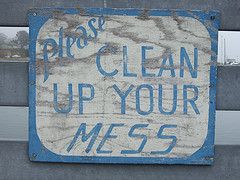8 Tips for Improving Your Messy Salesforce.com Data
 The ugly truth is that nearly every company that leverages a CRM system has the following traits:
The ugly truth is that nearly every company that leverages a CRM system has the following traits:
- Their data is not as good, useful or clean as it should or could be.
- They are embarrassed by their data, and worse yet, don’t fully trust it to support decision making.
- Their users feel depressed and sluggish when they think of having to do something with their data.
How about you? How good is your data? Here are 8 tips for improvement:
- Set up a Data Cleanliness Dashboard. The old adage applies here, “If you can measure it, you can manage it.” We suggest you put counts of data elements you care about on the dashboard. Think about data elements you need to support reporting and dashboards. Include data elements that you need to perform Lead Scoring , Market Segmentation or sales territory updates.

- Decide if certain important fields should be made required. Introduce some Validation Rules to enforce data entry standards based on conditional criteria (such as all Accounts of Type Customer must have a complete Billing Address). Focus on what is most important to your organization.
- Define and communicate your data standards to your users. Documentation is great (but not always looked at), so we suggest leveraging Help Text on Custom Fields to put explanations and expectations for individual field data entry right beside the field.
- Download Salesforce Labs’ free Data Quality Analysis Dashboards from http://sites.force.com/appexchange/listingDetail?listingId=a0N300000016cshEAA. For each of the main objects in the system, Salesforce.com will add two formula fields. These formulas either show each record’s score on a scale of 0 to 100 or the list of fields that are missing values. By modifying the formulas, you can score the data in your database based on the fields you care most about. This is a great way of looking more deeply into the value of the data that your organization possesses.
- Convene a data steering committee of key stakeholders for the system. Include stakeholders for systems that are integrated. Meet regularly- at least once a quarter, if not monthly. Set goals for improvements to your data. Discuss the above mentioned dashboards. Define cleanup projects, such as to improve Contact segmentation for an upcoming Marketing Campaign. Celebrate progress.
- Use Views. A great way to get someone to clean up something is to make it easy for them. Views in Salesforce.com are a perfect mechanism. Imagine if you wanted an intern to research and update the Website address for all Accounts in Nebraska. Simply setup a View called Accounts in Nebraska without Website. As she/he fills in the data, the list gets smaller. Once you create the View, copy and paste the URL to the View and send it to the person responsible for cleanup saying “Here is the list I want/need you to work on.” With the Enhanced List Views and In Line Editing features turned on, you can also create Views which allow Users to make mass updates to multiple records a the same time DIRECTLY WITHIN THE VIEW. (Note- this is not possible if more than one Record Type is visible in the View, and is not available for all fields.
- Establish and follow a set procedure for data mapping when importing new records. It is painstaking, but very worthwhile to review each column in the source file against each field in Salesforce.com to ensure a clean import.
- Leverage data tools such as CRMFusion’s DemandTools and DupeBlocker to help stay ahead of the natural atrophy of the records in your database. DemandTools isn’t just for dealing with dupes. You can also set scripts to run each night which fix data, such as converting all States, Provinces and Countries to two letter ISO codes. There are also import tools to better ensure cleaner loads of new data. DupeBlocker allows you to define criteria to catch dupes as they are entered. To learn more, check out www.crmfusion.com.
- Contact OpFocus! We perform data cleanliness and system health checks for companies on a monthly basis with our Managed Services offering.
Photo credit: Alan Goldblatt



